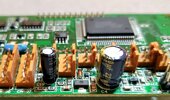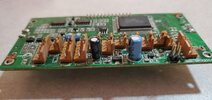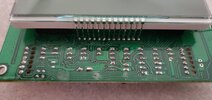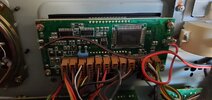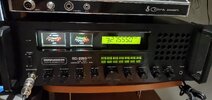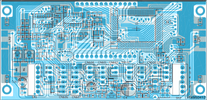Still looking for that Ranger RCI 2995 DX expert. It's a 2007 model. I'm having a problem with my 2995 DX not holding memory and I can't figure it out. I changed out the 2 electrolytic capacitors on the display board and that didn't not fix it. Say I'm dialed on 27.385 then I'll turn off the radio, turn it back on and it defaults back to 24.000 every time. I was told to change out the 2 caps. But nope that's not the problem. The original bigger cap was a 220uf 10V so I put in a 220uf 25V cause I didn't have any 10V laying around. Thanks for any help or suggestions.
You are using an out of date browser. It may not display this or other websites correctly.
You should upgrade or use an alternative browser.
You should upgrade or use an alternative browser.
-
You can now help support WorldwideDX when you shop on Amazon at no additional cost to you! Simply follow this Shop on Amazon link first and a portion of any purchase is sent to WorldwideDX to help with site costs.
Still Need Help Ranger RCI 2995 DX losing memory.
- Thread starter HavaV10
- Start date
Almost 30 years ago RCI changed the 2950 radio's computer from a "two-board" with separate computer and display to a single board. The new 1995 version had the 100uf capacitor in place of the lithium coin cell found in the first versions.
When we asked them about this, they said the capacitor would hold memory for a week.
Had the notion of substituting a half-farad or so supercap in its place, just to see if it made any difference. Still haven't gotten a "round tuit" for that idea.
Would be a bit awkward to measure the capacitor voltage after the radio is powered off. A meter would probably drain the capacitor pretty quickly just from current that it will draw.
A genuine puzzle.
73
When we asked them about this, they said the capacitor would hold memory for a week.
Had the notion of substituting a half-farad or so supercap in its place, just to see if it made any difference. Still haven't gotten a "round tuit" for that idea.
Would be a bit awkward to measure the capacitor voltage after the radio is powered off. A meter would probably drain the capacitor pretty quickly just from current that it will draw.
A genuine puzzle.
73
Hey Nomad,Almost 30 years ago RCI changed the 2950 radio's computer from a "two-board" with separate computer and display to a single board. The new 1995 version had the 100uf capacitor in place of the lithium coin cell found in the first versions.
When we asked them about this, they said the capacitor would hold memory for a week.
Had the notion of substituting a half-farad or so supercap in its place, just to see if it made any difference. Still haven't gotten a "round tuit" for that idea.
Would be a bit awkward to measure the capacitor voltage after the radio is powered off. A meter would probably drain the capacitor pretty quickly just from current that it will draw.
A genuine puzzle.
73
I have someone telling me that there is a coin cell battery butted up against the buzzer? You ever heard of that?
Assuming the "write after power-off event" theory is correct, I would be tempted to connect a battery pack of the same voltage to where C4 goes via a diode. C4 is the cap on the power rail for the micro and the eeprom. The diode will act as a switch isolating the battery from the board when the board is powered, but allow the battery to immediately take over when the power is cut. It will be .6v lower, but still enough to run the micro and eeprom.
The eeprom goes into data protection when Vcc falls below 1.4v and the micro needs 4v to operate. Of those two, the CPU is more sensitive to the cap bleeing down.
If we keep that voltage above 4v as described, we can find out if the cap is draining too fast without having a 'scope. Either it will retain its memory or it will not.
If that doesn't bring the memory back, we need to consider that the eeprom writes with every PTT or channel change event, or at a repetitious rate. It is somewhat possible that the eeprom was written too many times.
One way to see how often the eeprom is being written (and read) without a 'scope is to monitor the chip select pin. The micro should only be bringing it high to access it, so you are likely to see one of three things. It go high when you power cycle the radio, whenever you change a setting, or in a repetitious way (and we hope its not because that is pointless wear on the eeprom). The first two you can see with the meter in DC, the third may need the AC setting.
Overlay of CPU traces attached. Photoshopped the top and bottom into one.
The eeprom goes into data protection when Vcc falls below 1.4v and the micro needs 4v to operate. Of those two, the CPU is more sensitive to the cap bleeing down.
If we keep that voltage above 4v as described, we can find out if the cap is draining too fast without having a 'scope. Either it will retain its memory or it will not.
If that doesn't bring the memory back, we need to consider that the eeprom writes with every PTT or channel change event, or at a repetitious rate. It is somewhat possible that the eeprom was written too many times.
One way to see how often the eeprom is being written (and read) without a 'scope is to monitor the chip select pin. The micro should only be bringing it high to access it, so you are likely to see one of three things. It go high when you power cycle the radio, whenever you change a setting, or in a repetitious way (and we hope its not because that is pointless wear on the eeprom). The first two you can see with the meter in DC, the third may need the AC setting.
Overlay of CPU traces attached. Photoshopped the top and bottom into one.
Attachments
Last edited:
Thanks Nomad for all that information. Had a idea what about soldering in black/red wires into that C4 location and using a single battery holder for one 1.5 AA battery. Would that work?Assuming the "write after power-off event" theory is correct, I would be tempted to connect a battery pack of the same voltage to where C4 goes via a diode. C4 is the cap on the power rail for the micro and the eeprom. The diode will act as a switch isolating the battery from the board when the board is powered, but allow the battery to immediately take over when the power is cut. It will be .6v lower, but still enough to run the micro and eeprom.
The eeprom goes into data protection when Vcc falls below 1.4v and the micro needs 4v to operate. Of those two, the CPU is more sensitive to the cap bleeing down.
If we keep that voltage above 4v as described, we can find out if the cap is draining too fast without having a 'scope. Either it will retain its memory or it will not.
If that doesn't bring the memory back, we need to consider that the eeprom writes with every PTT or channel change event, or at a repetitious rate. It is somewhat possible that the eeprom was written too many times.
One way to see how often the eeprom is being written (and read) without a 'scope is to monitor the chip select pin. The micro should only be bringing it high to access it, so you are likely to see one of three things. It go high when you power cycle the radio, whenever you change a setting, or in a repetitious way (and we hope its not because that is pointless wear on the eeprom). The first two you can see with the meter in DC, the third may need the AC setting.
Overlay of CPU traces attached. Photoshopped the top and bottom into one.
You may have mistaken my reply with one from Nomad. He may have other suggestions.Thanks Nomad for all that information. Had a idea what about soldering in black/red wires into that C4 location and using a single battery holder for one 1.5 AA battery. Would that work?
And I will once again point out that the CPU needs 4v. No point in keeping the eeprom awake if there is nothing to talk to it.
forgot to mention that the frequencies I program into memory hold just fine. It's just when I turn it off and then back on it defaults to 24.0000 MHZAnd I will once again point out that the CPU needs 4v. No point in keeping the eeprom awake if there is nothing to talk to it.
They stopped making the first version with the coin cell in March 1995, if memory serves.
The 100uf cap takes its place in all of them made since then. A battery may or may not directly take the place of the capacitor. A battery-backed setup normally includes a diode to protect a non-rechargeable cell from being 'charged' by the 5-Volt supply when the radio is powered on. The later version built with the capacitor won't have that. Just putting a diode in series with the 3-Volt cell or battery might work.
Never tried it.
73
The 100uf cap takes its place in all of them made since then. A battery may or may not directly take the place of the capacitor. A battery-backed setup normally includes a diode to protect a non-rechargeable cell from being 'charged' by the 5-Volt supply when the radio is powered on. The later version built with the capacitor won't have that. Just putting a diode in series with the 3-Volt cell or battery might work.
Never tried it.
73


